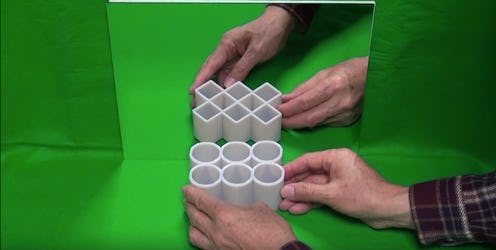
So, OK, optical illusions do tend to seem much more of an unsolvable mystery after, say, your first day back to work after a three-day holiday weekend — but I promise, regardless of when you check this one out, you'll immediately wonder how the ambiguous cylinder illusion works. This is a good one, you guys. Enraging, yes, but good.
Dr. Sugihara Kukichi, an engineering professor at Japan's Meiji University, created this trick for the 2016 Illusion of the Year competition (he placed second). That is a thing. I have verified it. It's sponsored by the Neural Correlate Society, a non-profit that supports research into the relationship between perception and cognition. This kind of seems like Dr. Kukichi's "thing"; though his ambiguous cylinder illusion has been blowing up the interwebs since it was first posted on Reddit five days ago, the Japanese professor has made a career of dealing with objects that absolutely screw with our minds when put in front of a mirror. His latest series is called "Impossible Objects," and it's a new class of objects that seemingly disappear when placed in front of a mirror.
Still, I think the ambiguous cylinder illusion is my fave. Here's the basic premise: there's a small plastic square — or is it a circle? Based on whether you're looking at it in a mirror or in person, it's a shape that appears to simultaneously be two different shapes.
Are you stumped? Want some time to do some thinkin' on it? Here's the full video of the illusion in action, in case you need more visual amazingness to ponder:
But once you're done with all that, uh, thinkin', check out the thinking that Devin Montes from the Make Anything YouTube channel did — because he "reverse engineered" this optical illusion, 3D printed it, and made a video explaining truly WTF is going on with this shape.
You ready?
This is the real shape:
It's the exact middle ground between a circle and a square. A squircle, if you will. The tops of the sides are wave patterns. Two sides dip up, and two sides dip down. I'm not explaining this well because it's hard to explain, so I'll just let Devin show you:
Combined, the sides "correct" the shape, depending on which way the shape is projected into a mirror.
Check out the full explanatory video below:
Cool, right? And mind-blowing? And all sorts of amazing? Yep, I thought so, too. Even in my hazy, post-holiday brain.
Welcome back, everyone. May this week treat you well.
Images: Illusion of the Year (2), Make Anything (2)/YouTube